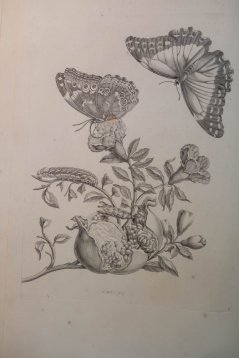
News
Crossing Boundaries: Maria Sybilla Merian, where science meets heritage
The theme of the Opening of the Academic year 2021-2022 is Crossing Boundaries, or: how Science and Art can reinforce and inspire each other. The work of 17th-century artist and ecologist Maria Sybilla Merian, can be seen as an excellent example of this mutual reinforcement.
Crossing Boundaries
According to the President of the Executive Board, Louise Fresco, groundbreaking discoveries do not always result from well-defined research plans. She makes a case for the importance of failure and serendipity. A connection to art, in all its forms, can serve as a source of inspiration and can encourage surprising perspectives.
The importance of collaboration between art and the practice of science is clearly reflected in the Special Collections department of WUR: many famous scientists were either artists or worked closely with people who were active in the arts.
Maria Sibylla Merian: combining art with research
An excellent example of someone who was an fine artist as well as a serious researcher is the 17th-century artist and ecologist Maria Sybilla Merian. In addition to an unparalleled artistic talent in the field of natural history, she can be considered a pioneer in the field of entomology. She was one of the first to study and describe in detail the metamorphosis of a caterpillar to a butterfly. The texts she added to her breathtaking drawings contain a wealth of information about the insects she studied.
In 1699, Maria left for Suriname where she intensively studied insect life for two years. In 1705, she published the impressive work Metamorphosis Insectorum Surinaminensium about this journey. The work consists of 60, coloured, engravings of butterflies and other insects and their host plants. She also provided a scientific description with each engraving.
Pirate edition
Several editions of this publication have been published. Special Collections of WUR Library has a coloured "pirate edition". A pirate edition is an illegally printed copy of the work with coloured plates but no text. The beautiful plates from this edition can be viewed via the WUR Image Collections.
Black and white edition
In addition to the pirate edition, Special Collections holds a black-and-white edition of the work, containing both the plates and the accompanying texts.

This last copy has also been merged with another work by Merian, “The European insects, closely examined, painted after life, and put into print”. The detailed descriptions of the transformation process from egg to butterfly in this volume testify to Merian's unique observational and research qualities.
Moreover, they show how progressive Merian was, if you consider that in the 17th century it was generally believed that caterpillars arose from dead matter. Thanks in part to Merian's research, the idea of spontaneous generation was relegated to the realm of fables.